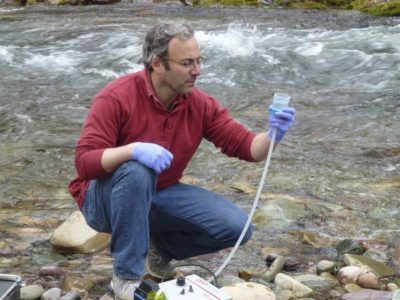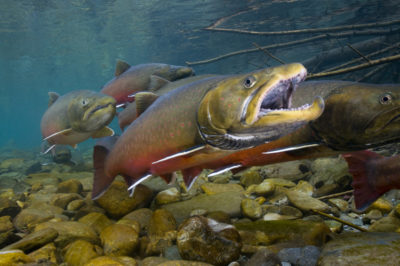A U.S. Forest Service technician heads out to the Blackfoot River in western Montana and pumps water through a small filter, five liters every time she stops. In a single day, she gathers dozens of samples, bringing back to the lab each of the fine mesh filters that the river water passed through.
U.S. Forest Service biologist Michael Schwartz gathers water to be sampled for eDNA from Rattlesnake Creek in Montana. Kellie Carim/U.S. Forest Service
The filters contain DNA for species — whether brook trout, stone flies, wood ducks, or river otters — that have swum in that stream in the last day or two, up to a kilometer above the sample site. Every insect, fish, or animal continually sloughs off bits of its DNA — in its feces or from its skin — and just a single cell of the invisible, free-floating genetic material can tell researchers which species are present in a river or other water body.
Environmental DNA, or eDNA, is at the center of a brand new kind of fish and wildlife biology, and it is such a powerful tool that it’s transforming the field. eDNA was first used to detect invasive bullfrogs in France a decade ago. It was used in North America for the first time in 2009 and 2010 to detect invasive Asian carp in and around the Great Lakes. Since then, its use has grown exponentially, primarily in marine and freshwater environments.
“You can’t manage a species if you don’t know where it is — even 80-pound Asian carp, because you can’t see them underwater,” said Cornell University biologist David Lodge, who participated in the Asian carp study. “So eDNA is particularly powerful in aquatic systems.”
The DNA is so easy and inexpensive to gather and assay — $50 to $150 to test each sample — that the U.S. Forest Service has launched a project to collect DNA from all rivers and streams across the western U.S. to create an Aquatic Environmental DNA Atlas.
“Environmental DNA is turning out to be an amazing tool in allowing us to detect the distribution of species, a distribution that has been invisible to us in the past,” said Michael K. Schwartz, director of the Forest Service’s National Genomics Center for Wildlife and Fish Conservation in Missoula, Montana. “It has remarkable efficiency.”
The U.S. Forest Service has launched a project to collect DNA from all rivers and streams across the western U.S.
Experts say use of the technology is in its early stages and that as it evolves it will become even more powerful, providing an even deeper look into the genetics of aquatic ecosystems, including ocean environments.
The next step in the evolution of the technology would be to estimate the abundance of a species in a river or other water body based on the quantity of DNA found in samples. “That is going to continue to be a research frontier,” said Lodge.
Scientists say that eDNA can be used not only to detect the presence of invasive species in a river, lake, or ocean, but also to help reintroduce native species, to study genetic diversity among fish stocks, and to better manage commercial and endangered species.
Until now, the primary way to conduct distribution studies was to physically see, count, and describe species, a time-consuming process that is expensive and often hit-or-miss. That leaves huge gaps in the knowledge of where species are, which often confounds species management.
One of the best examples of the transformative nature of eDNA is in assessing the distribution of bull trout across its entire range. Bull trout are a threatened species in the U.S. Northwest, and their habitat is declining because of deteriorating water quality and warming water temperatures. Cold water is essential to their spawning.
By knowing where the fish live, managers can direct funding for protecting and restoring riparian habitat. Until recently, though, the only way to find and count bull trout was to do an electro-shocking census. That means a biologist would take equipment to the river to shock fish in the water and count them as they float, stunned, to the surface. That technique is time-consuming, not always permitted, and can survey only a fairly small area with each census.
With eDNA, a single sample can tell which species have been in a river a kilometer upstream from the sample site within the last 24 to 40 hours — that’s how long the DNA lasts in the water. Tests with caged fish have shown that just three fish in a river can give a 100 percent detection rate, and one fish 85 percent.
The range-wide bull trout study, conducted by the Forest Service, first looked at the temperature of streams that fit bull trout requirements. Then eDNA samples were taken to detect the trout’s presence in those reaches. “We’ve been able to detect bull trout in streams in a matter of days that have taken some of our colleagues years to confirm,” says Schwartz. And there were surprises. “In a couple of locations where bull trout were not supposed to be, we have multiple detections throughout the drainage,” Schwartz says.
Researchers have used eDNA testing to assess populations of bull trout, a threatened species in the U.S. Northwest. Wade Fredenberg/USFWS
eDNA technology is being used in other parts of the world as well.
In the Dinaric Alps, a mountain range that runs through Croatia and Slovenia, there’s a curious creature called the olm — a blind, flesh-colored salamander also known as a baby dragon — that lives its entire life underground. “They are a symbol of our country, but are still as mysterious as they were a hundred years ago,” Peter Trontelj of the Department of Biology at the Ljubljana Faculty of Biotechnology told an English-language news site. The only way to know where they lived was to dive into a cave and find them or to see them washed out of a cave after a heavy rain. But after testing for eDNA, biologists confirmed their presence in 10 caves where they were known to exist, and discovered new populations in five others.
In Japan last year, scientists found that eDNA sampling gave them a rough “snapshot” of the distribution and biomass of fish species in a bay in the Sea of Japan.
eDNA assessment has also become a new, powerful weapon in the fight against invasive species.
The first published study of the use of eDNA for conservation purposes was in 2008 in France. The American bullfrog has become an invasive species in France and around the world; not only does it displace native species, but the bullfrog also carries the virulent amphibian killer fungus, chytrid. Early detection of bullfrogs can make a big difference in the ease of eradicating them, but they are hard to find. Calling the frogs only locates a small portion of the population – and even then the census needs to be done at night and in certain weather conditions. With eDNA, French researchers were able to easily confirm the bullfrog’s presence in some ponds and target those for removal.
The identification of fugitive DNA is also playing a role in the detection and eradication of invasive fish, a growing problem. Asian carp, a voracious plankton eater, would pose a huge threat to the ecology of the Great Lakes if they become established there, since they eat so much plankton they starve young fish of other species. While a few have been detected, biologists are monitoring rivers and canals that feed the lakes for early signs of more invaders.
In the western U.S., one target of eDNA searches has been brook trout, an interloper from the East that outcompetes native species. In one eradication scenario, managers would capture native fish and then use poison to kill the brook trout, so that native species could be re-introduced. If biologists find brook trout DNA after poisoning a river, they could go back in and electrofish to see where the stragglers may be hiding.
“Sometimes they have detected one or two or three fish finding refuge in a side channel,” said Schwartz. “In one case they found a dead brook trout under a rock that didn’t flush out of the system.”
That’s one of the drawbacks of the technology — there’s no way to tell if the DNA of an invasive species is dead or alive. A great deal of time and effort could be spent trying to find an exotic carp, for example, that was already dead.
‘Any group of students can collect samples in lakes, rivers, and ponds,’ says one researcher.
The ease and low cost of collecting samples has enabled widespread use of the powerful technique and eDNA can be gathered by just about anyone. It would be prohibitive to test all of New York state’s 7,600 lakes and 70,000 miles of rivers and streams for invasive species. So researchers at Cornell University send detection kits to schools across New York as a citizen science project. Students gather water samples as part of their science class and ship the filters to the university. When the results are returned, the students enter them in a database.
“Any group of students can collect samples in lakes, rivers, and ponds,” said Donna Cassidy-Hanley, a senior research associate at the Cornell University College of Veterinary Medicine. “Once the data is plotted, the people doing the eradication work can see where the species has spread.”
Students recently found DNA from the round goby, an aggressive invasive fish, and confirmed its presence in Oneida Lake in the Finger Lakes, where it was not known to exist. “It sets the stage for corrective action,” Cassidy-Hanley said.
As new techniques evolve, a single water sample will be sufficient to detect which communities of organisms exist in a waterway or in the ocean. “In the future,” write Phillip Francis Thomsen and Eske Willerslev, two Danish experts from the Center for GeoGenetics at the Natural History Museum of Denmark, “we expect the eDNA approaches to move from single-marker analysis of species or communities to meta-genomic surveys of entire ecosystems to predict spatial and temporal biodiversity.” That would greatly enhance conservation efforts.
One of the problems facing conservation biology these days is that not all populations within a species have the same DNA. Some populations of bull trout might be better adapted to surviving in warmer water, for example, or even adapted to specific drainages. If the DNA for those adaptations are known — and in most cases they aren’t yet — then finding certain specially adapted populations to be relocated or protected will be a lot quicker and easier with eDNA.
“This technique will help solve a lot of the problems of conservation across broad scales,” said Schwartz.




